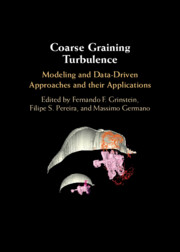Book contents
- Frontmatter
- Contents
- Contributors
- Prologue
- Part I Paradigms and Tools
- 1 Numerical Simulations and Coarse-Graining
- 2 An Overview of Scale-Resolving Simulation Models for Practical Flows
- 3 Filtering Approaches and Coarse Graining
- 4 Filtered Density Function
- 5 Symmetries, Subgrid-Scale Modeling, and Coarse Graining
- 6 Coarse-Graining Turbulence Using the Mori–Zwanzig Formalism
- 7 Data-Driven Modeling for Coarse Graining
- 8 Verification, Validation, Uncertainty Quantification, and Coarse-Graining
- Part II Challenges
- Epilogue
- Abbreviations
- Index
- References
6 - Coarse-Graining Turbulence Using the Mori–Zwanzig Formalism
from Part I - Paradigms and Tools
Published online by Cambridge University Press: 31 January 2025
- Frontmatter
- Contents
- Contributors
- Prologue
- Part I Paradigms and Tools
- 1 Numerical Simulations and Coarse-Graining
- 2 An Overview of Scale-Resolving Simulation Models for Practical Flows
- 3 Filtering Approaches and Coarse Graining
- 4 Filtered Density Function
- 5 Symmetries, Subgrid-Scale Modeling, and Coarse Graining
- 6 Coarse-Graining Turbulence Using the Mori–Zwanzig Formalism
- 7 Data-Driven Modeling for Coarse Graining
- 8 Verification, Validation, Uncertainty Quantification, and Coarse-Graining
- Part II Challenges
- Epilogue
- Abbreviations
- Index
- References
Summary
Originating from irreversible statistical mechanics, the Mori–Zwanzig (M–Z) formalism provides a mathematical procedure for the development of coarse-grained models of complex systems, such as turbulence, that lack scale separation. The M–Z formalism begins with the application of a specialized class of projectors to the governing equations. By leveraging these projectors, the M–Z procedure results in a reduced system, commonly referred to as the generalized Langevin equation (GLE). The GLE encapsulates the system’s behavior on a macroscopic (resolved) scale. The influence of the microscopic (unresolved) scales on resolved scales appears as a convolution integral – often referred to as memory – and an additional noise term. In essence, fully resolved Markovian dynamics is transformed into coarse grained non-Markovian dynamics. The appearance of the memory term in the GLE demonstrates that the coarse-graining procedure leads to nonlocal memory effects, which have to be modeled. This chapter introduces the mathematics behind the projection approach and the derivation of the GLE. Beyond the theoretical developments, the practical application of the M–Z procedure in the construction of subgrid-scale models for large eddy simulations is also presented.
- Type
- Chapter
- Information
- Coarse Graining TurbulenceModeling and Data-Driven Approaches and their Applications, pp. 177 - 201Publisher: Cambridge University PressPrint publication year: 2025

